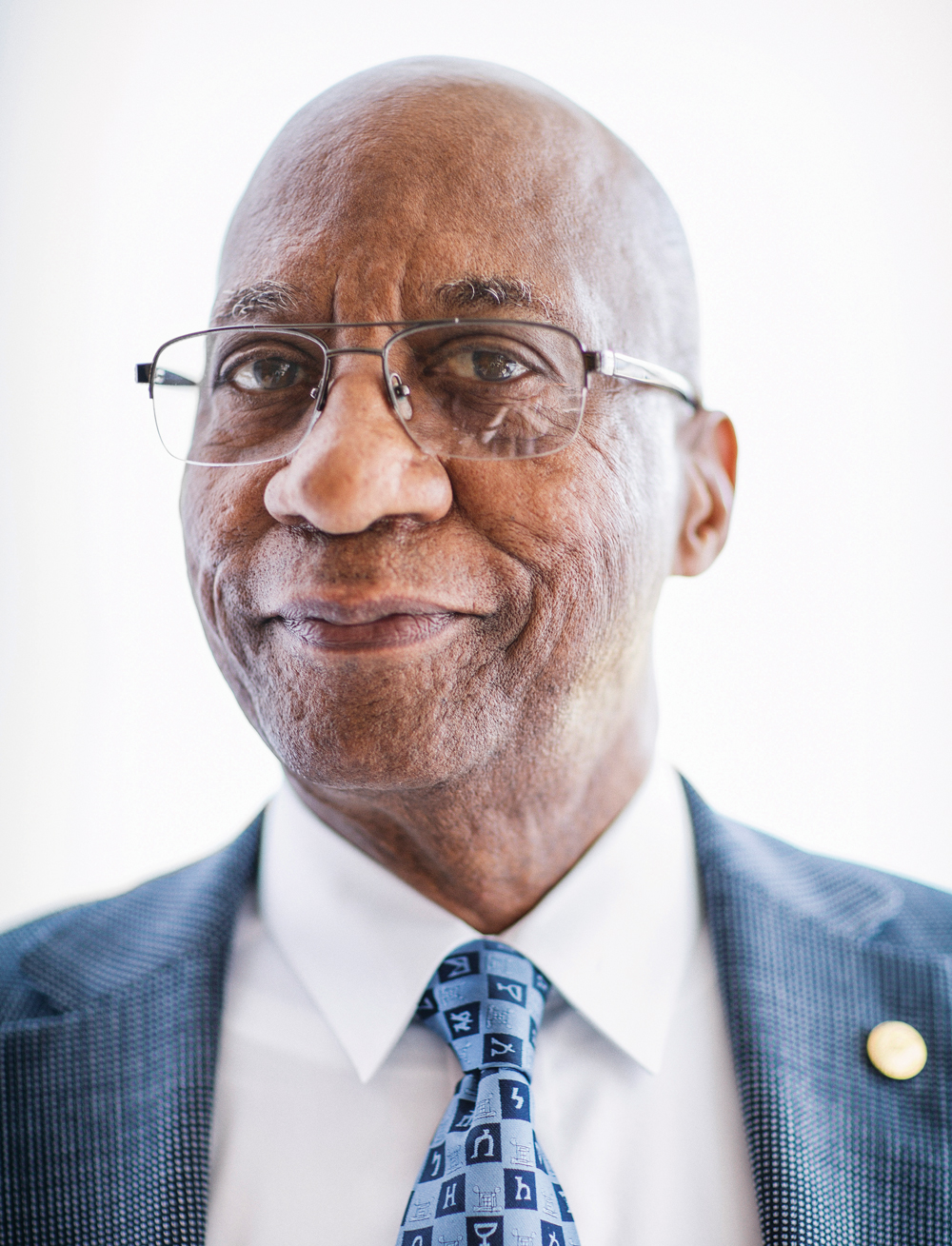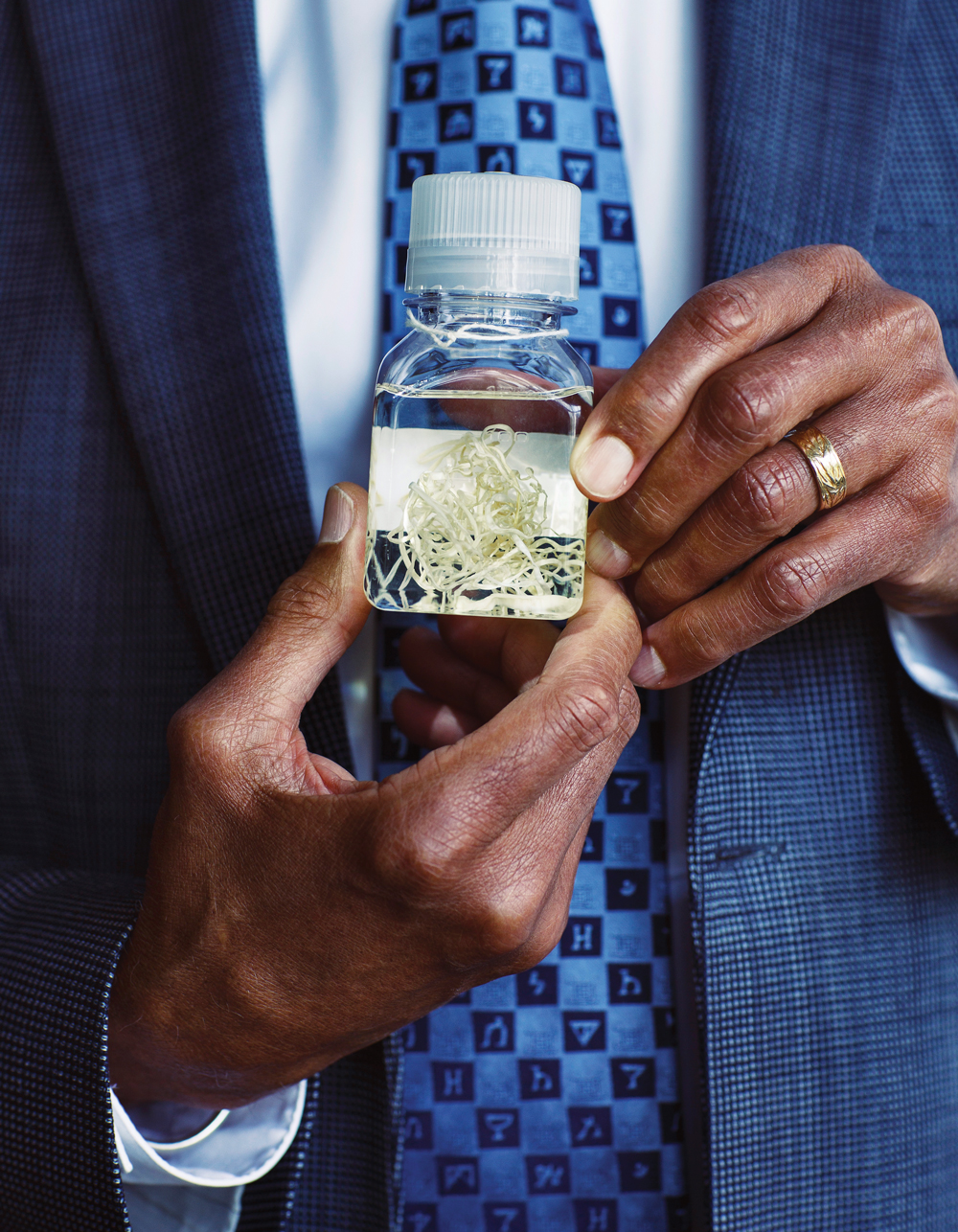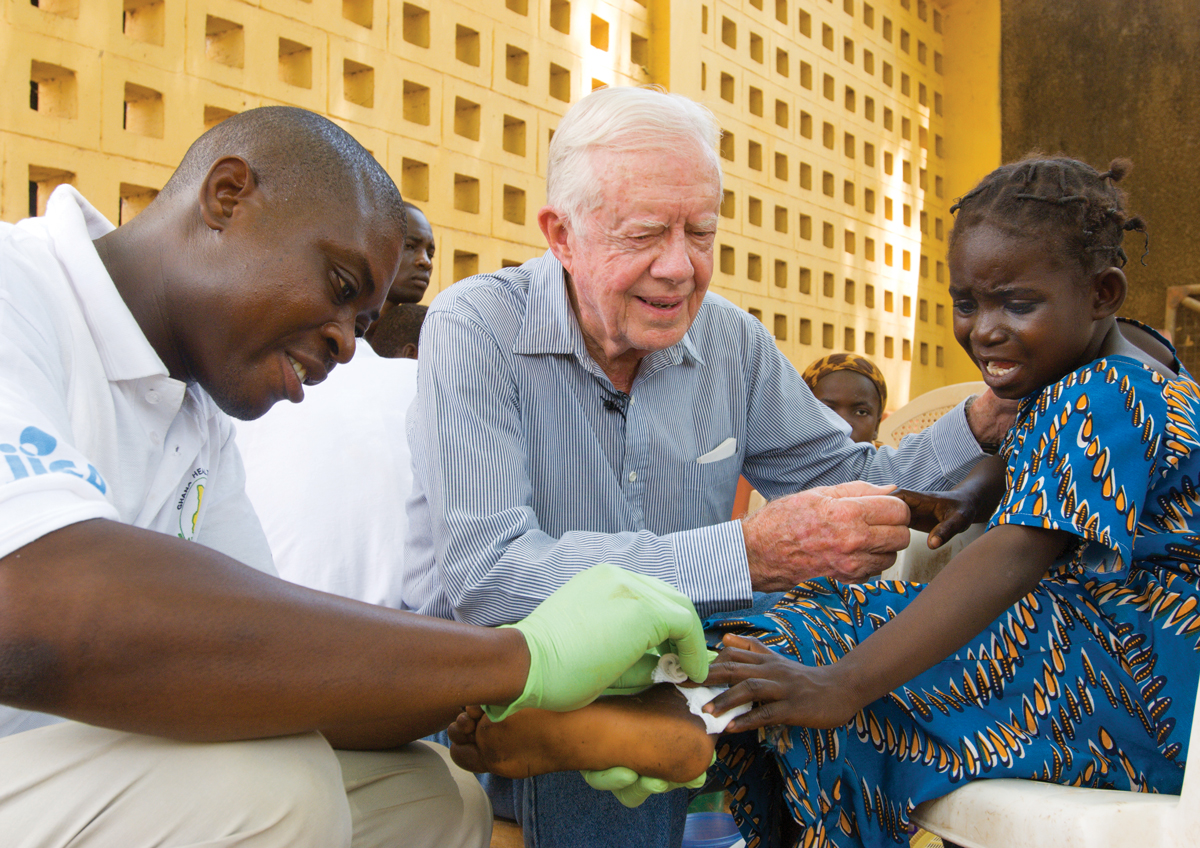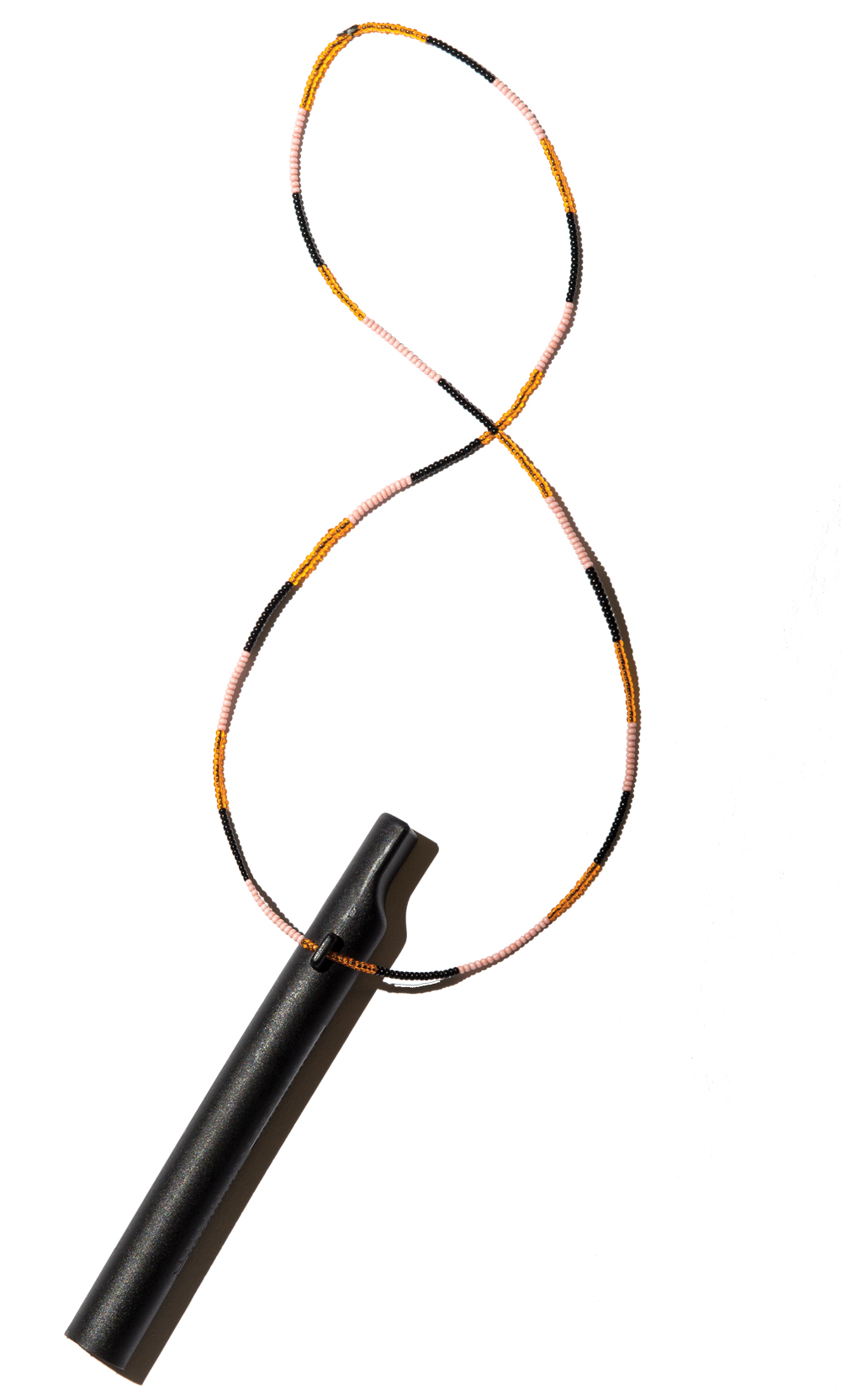
Photograph by Melissa Golden
At an open-air hospital in northern Ghana, Donald Hopkins watched a small girl endure a medical ordeal unseen in the United States.
It was 2007, and four-year-old Rafia Fusseini was getting treated for Guinea worm, a parasite that infected her after she drank contaminated water and then grew inside her body. Now it was burrowing out through her skin. Rafia sat on a chair, dressed in a blue-and-red print blouse, as a healthcare worker slowly guided the worm through an ulcer on her leg, taking care not to tear it as it emerged. Rafia’s mouth was open in agony, her cheeks wet with tears. Beside her stood former President Jimmy Carter and his wife, Rosalynn, who leaned forward and touched the girl tenderly.
“She was in so much pain,” says Hopkins, special advisor for Guinea worm eradication at the Atlanta-based Carter Center, as he looks at a photo from that day. “There were scores of other people there, most of them children, all wailing.” Guinea worm disease is seldom fatal, but as the worm exits the body—a process that can take weeks or months—the pain is searing, like a hot cigarette pressed against the skin. A reporter then traveling with Hopkins described the hospital visit as “a scene out of hell.”
Hopkins, a physician who has dedicated 37 years to fighting Guinea worm disease, was frustrated as he witnessed Rafia’s anguish that day. Even as the number of Guinea worm cases had plummeted from an estimated 3.5 million worldwide in 1986 to 25,000 in 2006, Ghana was starting to backslide. In February 2007 the country had reported more than 1,000 new cases, up from 622 a year earlier. Hopkins knew this uptick was preventable, if only the government would act more aggressively.
Yet that day proved pivotal. Carter’s visit made international news. “The embarrassment and pressure went a long way toward getting the political authorities to pay serious attention,” Hopkins says. Carter also leaned on Ghana’s president, warning—in the former U.S. president’s recollection—that if the West African country didn’t make progress, “we were going to change the name from Guinea worm to Ghana worm.” In 2010 Ghana recorded its last case; it was certified worm free in 2015.
Now Hopkins is approaching an even greater milestone in the effort that has consumed half his life. In 2016 the three countries that still harbored Guinea worm disease—which has no vaccine and no modern medical treatment—reported just 25 cases. Health officials believe that, with vigilance, the disease will soon be eradicated globally.

Photograph by Melissa Golden
If that happens, there will be much credit to go around. But the greatest accolades will go to Hopkins, whose rigor and persistence have propelled the decades-long effort.
“Don will give everyone and his grandmother credit for everything,” says Jeffrey Koplan, vice president for global health at Emory University and former director of the Centers for Disease Control and Prevention (CDC). “But I firmly believe this would not have been achieved in the absence of Don.”
The self-effacement Koplan describes is evident in Hopkins’s very physical presence. He has a shaved head and, at 76, a still youthful, handsome face. He speaks softly, gesticulating but never wildly, relaying his own history in short bursts of understatement. His command of dates and numbers and public health subtleties is encyclopedic and immediate. Ask why he became a physician, though, and he struggles to articulate the reason.
Hopkins grew up in Miami’s Bahamian community in the 1940s. There were no physicians in his family. His immigrant father was a carpenter, his first-generation mother a seamstress. He only recalls being inside a doctor’s office twice as a young child, first for vaccinations and later when he fell into a pool of hot water and scalded his arms and legs. Yet when adults asked what he wanted to be when he grew up, “I remember always responding, ‘I want to be a doctor.’ It was just something that was there,” he says.
The seventh of 10 living children and the first born in a hospital, Hopkins attended segregated schools, carrying an “almost daily awareness” that the scribbles inside his textbooks belonged to the white kids who had used them first. In 10th grade he took a test that qualified him to leave high school early and enter Morehouse College on a three-quarter scholarship. It was a significant opportunity. “I knew we needed the money,” he says.
It was during his undergraduate studies that Hopkins’s interest in tropical diseases was piqued. He had received a grant to study abroad, and that year he and some other expat American students boarded a boat to Alexandria, Egypt. From there, they took trains south to Cairo and Luxor. Hopkins was struck by the number of Egyptians he saw with inflamed and clouded eyes, flies buzzing around the sockets. Later he would learn they suffered from trachoma, a bacterial infection that can cause irreversible blindness. “As a fellow human being, I thought, ‘I would really like to be able to help people like this,’” he says.
After finishing medical school at the University of Chicago—where he was the only black student in his graduating class—and completing an internship, Hopkins applied to the U.S. Public Health Service and asked to work in Africa. Someone forwarded his application to the CDC in Atlanta, which, unbeknownst to him, was recruiting for a global smallpox eradication program.
While there had been attempts before to eradicate a disease worldwide, smallpox posed an exceptional threat. “It didn’t matter how rich your country was,” Hopkins says. Even though endemic smallpox had been eliminated from the United States in the late 1940s, infected individuals could still import the disease. The CDC hired Hopkins in 1967—the same year the World Health Organization (WHO) stepped up its eradication efforts—and posted him to Sierra Leone, which then had the highest known smallpox rate in the world.
Smallpox has been called “the most terrible of all the ministers of death.” A contagious, often deadly disease spread by close contact, it scarred and blinded its victims, killing 300 million in the 20th century alone. Sierra Leone was hit by an epidemic the year before Hopkins arrived, and it fell to him—just 26 and newly married—to advise the national government as it responded.
“I was too young to be cynical,” he says. “It seemed very logical to me that we had a vaccine that, once you gave it to people, essentially protected them for life. The challenge was to mass-vaccinate people.”
Hopkins and his team set out to do that, equipped with jet injectors that could deliver 1,000 shots per hour. They traveled by plane, pick-up truck, and Boston Whaler boat to province after province, circling the country counterclockwise. Where they were no roads, they’d often hike. “There were lots of snakes,” Hopkins says of those walks. “I was not at all fond of those.” Villagers welcomed the vaccine, he says, “They knew what smallpox was, they feared it, and they were grateful for the help.”
Still, he felt the approach could be more deliberate. At any one time, no more than 5 percent of Sierra Leoneans were living near outbreaks, he says. Wouldn’t it be more efficient to target those places—even if they were not yet scheduled for mass vaccinations—before the disease spread?
A few months after he began the job, Hopkins embraced a new strategy developed in Nigeria: Instead of focusing solely on mass inoculation, the team he was on would step up its surveillance; when an outbreak occurred, doctors would rush to the scene and try to contain it by vaccinating the people who lived nearby. Not every public health leader embraced his method. Back then, mass vaccination was so widely accepted as the default method for eradicating smallpox that any departure aroused skepticism. “But Don bought into that strategy,” says former CDC associate director for policy coordination Elvin Hilyer, “and lo and behold, in a remarkably short period, smallpox is gone.” Sierra Leone reported its last case in 1969, and disease was formally pronounced dead worldwide in 1980.
Having helped wipe out one scourge, Hopkins was well positioned to lead the effort to eradicate a second. “I can’t believe it’s an accident that Don was involved in both,” says Mark Siddall, a parasitologist at the American Museum of Natural History in New York and curator of the Carter Center’s Countdown to Zero exhibition, which explores the history of global efforts to eradicate diseases, including Guinea worm disease.
Hopkins first glimpsed a Guinea worm in an undergraduate textbook. He never forgot the photo of a worm emerging from a woman’s body. Then in 1980—after studying and teaching at Harvard, fighting smallpox in India, and finally returning to the CDC as assistant director for international health—he found himself chatting with a French physician at a WHO meeting in Switzerland. The Frenchman described seeing Guinea worm while working on the Ivory Coast and then watching in fascination as the disease declined precipitously after the government brought in safe drinking water.
Guinea worms start as larvae, which are consumed by water fleas. People ingest the fleas when they drink contaminated water from ponds, streams, or open wells. Inside the stomach, gastric juices dissolve the fleas, releasing the larvae, which can grow into worms up to three feet long. After mating within their host’s body, the males die. But the females need to emerge to release their larvae, so they bore through their host’s skin a year after the original contaminated fleas are consumed. The worms potentially can emerge anywhere, even the eyes. Seeking relief from the agony, sufferers often plunge their bodies into water, which stimulates the worms to release their larvae, and the cycle begins anew.
The disease causes more than physical torment. It keeps farmers out of their fields and children out of school in places so destitute that they cannot afford these absences. “This is the quintessential disease of forgotten people in forgotten places,” says Ernesto Ruiz-Tiben, who now directs the Carter Center’s Guinea worm eradication program.
The surefire way to prevent Guinea worm disease is to build and use safe drinking water systems. But there are cheaper, lower-tech remedies. The water flea is large enough that it can be easily removed by pouring drinking water through a cloth or steel mesh filter (or even a T-shirt). Sufferers must be kept away from the water supply while the worms are emerging. And ponds can be treated with a mild chemical to kill the larvae. Eradicating Guinea worm disease means driving the species to extinction; Guinea worm disease cannot survive without its hosts.

Photograph courtesy of the Carter Center/L. Gubb
In 1981 the United Nations’ International Drinking Water Supply and Sanitation Decade was slated to begin. Yet reading an issue of WHO’s magazine devoted to the Water Decade—during the same 1980 meeting where he chatted with the French doctor—Hopkins was surprised to see no reference to Guinea worm disease. (“I went through it twice,” he says.) That night, with his wife asleep in their Swiss hotel room, he sat in the bathroom and made notes about how to address the disease, including adding its eradication to the Water Decade agenda.
It would not be an easy sell. “WHO was not enthusiastic at all, on the contrary,” he says. Guinea worm disease was mostly unknown in the developed world, there was no vaccine, and its one-year incubation period meant progress would be slow. Plus, stamping out smallpox was “such a huge enterprise that many people were tired,” says Ruiz-Tiben.
But Hopkins says his work in Sierra Leone “immunized me against pessimism. When people said to me, ‘You’re not going to be able to eradicate Guinea worm disease,’ I had heard all of that about smallpox. So I just brushed it off.” The CDC allowed him to spend a fraction of his time working on Guinea worm disease eradication, and among his early projects was assisting Nigeria, an influential country with a respected health minister, to organize a conference on Guinea worm disease in 1985. Nigeria’s interest lent gravitas to the effort. “This was not just some oddball Don Hopkins, pushing his pet thing,” he says. “This was something that an important country was very serious about.” Finally, in 1986, WHO’s governing body passed a resolution calling for the eradication of Guinea worm disease.
At CDC, Hopkins was able to lay groundwork in the fight. But with neither a mandate nor a significant budget to fight Guinea worm disease, he says, “CDC alone would not have been able to take this much further.” In 1987, after climbing the ranks and serving briefly as acting director, Hopkins left for the Carter Center, which embraced his vision of Guinea worm disease eradication and now coordinates the international effort. There, Hopkins knew he could work on the disease full-time, with more resources and with President Carter’s global influence. Hopkins has remained at the center, in various roles, ever since.

Photograph courtesy of the Carter Center/L. Gubb
If all it took to end Guinea worm disease were water filters and larvicide, Hopkins and his colleagues would have finished the job years ago. What it also takes is the deft navigation of cultural differences and political rivalries—not to mention armed conflicts, broken-down health systems, bad roads and no roads. Diplomacy is essential on a grand scale: President Carter brokered a six-month ceasefire in Sudan’s civil war in 1995 to allow Guinea worm workers access. It’s also needed at the household level, where senior wives in polygamous marriages sometimes withhold water filters from their juniors. Guinea worm is the subject of considerable mythology—the worms have been viewed as both messages from ancestors and the product of witchcraft—and those beliefs need to be addressed respectfully. So do critics who question the allocation of public health dollars, like the Nigerian women who, according to the New York Times, blocked a pond and shouted, “Why don’t you go treat AIDS instead?”
Dealing with these complexities means building trust. “When you enter a village, you leave your culture behind,” says Adam Weiss, associate director of the Carter Center’s Guinea worm eradication program. “We can’t come in heavy-handed and say, ‘You must do X, Y, Z.’ We all know how human beings respond to that.”
Weiss remembers, in 2011, when flooding in South Sudan forced both him and Hopkins to hunker down in a remote settlement of mud huts with thatched roofs. As soon as their Land Cruiser arrived at the village, Hopkins jumped out of the vehicle and started walking house to house. “He would greet families in their language, ask to see their filters, communicate about what the household knew about Guinea worm,” Weiss says. “It was real engagement, reinforcing the work of the volunteers, of the leadership in the community. He was always ready to be their champion.”
Eradicating a disease also requires rigorous data collection and management. That’s evident at WHO and Carter Center’s annual meeting of Guinea worm eradication program managers from around the world: two days of PowerPoint presentations, in French and English, that lay out all the previous year’s cases in penetrating detail. There are conversations about surveillance programs, including monetary rewards for villagers who report their sick neighbors, and updates on scientific research.
Hopkins, the elder statesman, listens attentively from a central seat. He asks questions, pushes for specificity, and delivers praise—along with quiet, precise criticism. “He can take a lot of data, synthesize it quickly, and present a cogent argument,” says his former CDC colleague P. Craig Withers, who now manages international health activities at the Carter Center. “That’s a fairly rare trait, [which] he doesn’t understand . . . he’s always wondering why others can’t do the same.”
The global incidence of Guinea worm disease today is tiny compared to the 3.5 million cases in 1986. Still, the last vestiges of the disease—which in 2016 was reported in Chad, Ethiopia, and South Sudan—will take extraordinary effort to eliminate. South Sudan is a good example of why. “We just came off a long and destructive war,” says Makoy Samuel Yibi Logora, the country’s eradication program director. “The road infrastructure is terrible. The health system is nonexistent. We have a really prolonged rainy season.” Still, the country reported only six cases in 2016, compared to 20,582 a decade earlier.
Chad, which reported 16 of the world’s 25 cases last year, has thrown a special challenge at public health experts: There, the worm has unexpectedly appeared in dogs, which must be tethered to keep them away from ponds but often aren’t. To become extinct, Guinea worm needs to be eliminated from both human and canine hosts. “When that happens,” Hopkins says, “there will be no place for this worm to come back from.”
Despite the frustrating bumps, Hopkins insists the end is close and says he won’t retire until the disease is completely wiped from the planet. A heart attack in 2015 led him to stop flying (he lives in Chicago) and reduce his hours to half time. Even though he has less stamina than he used to, Hopkins says the imminence of global eradication energizes him. “There’s no way I can stop,” he says. “My wife would love to get all of these Guinea worm papers out of this house so she has more room. But I want to see the end of this worm.”
“You must not think of this as entirely voluntary,” he says of his continued work. “I’ve got the tiger by the tail and I can’t let go.”
This article originally appeared in our August 2017 issue.









![The North Carolina Museum of Natural Sciences’ newest exhibit is a [pre]historic first](https://cdn2.atlantamagazine.com/wp-content/uploads/sites/4/2024/04/DD-3-100x70.jpg)




